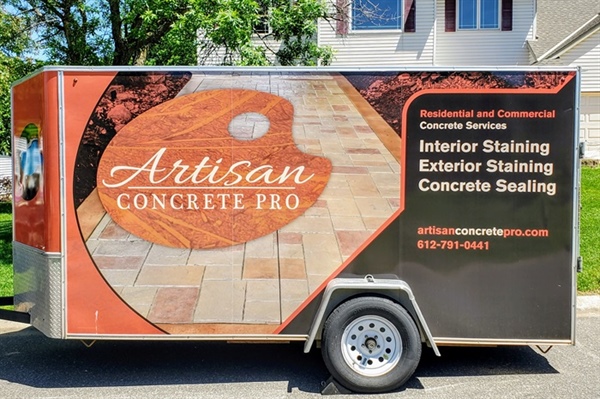The Step-by-Step Process of Cleaning and Sealing Concrete Floors

Concrete floors are known for their durability, but maintaining them properly requires a structured approach. Whether it's a residential garage, a commercial warehouse, or an outdoor patio, regular cleaning and sealing help preserve the floor’s integrity and appearance.
Over time, dirt, oil stains, and exposure to the elements can degrade concrete surfaces, leading to discoloration and structural weakening. Property owners can keep their floors in excellent condition by following a step-by-step process while preventing costly repairs.
In this guide, the Artisan Concrete Pro explores the essential tools and materials needed for effective concrete cleaning, ensuring long-lasting protection and a professional-grade finish.
What Tools and Materials Are Needed for Effective Concrete Cleaning?
Proper concrete cleaning starts with gathering the right tools and materials. The essentials include a stiff-bristle brush, a mop, a wet/dry vacuum, and a power washer for deep cleaning. Cleaning solutions vary based on the type of stain—mild dish soap and water work for general dirt, while degreasers or alkaline cleaners tackle oil and grease. A diluted acid-based cleaner can be used for more stubborn contaminants, though it should be handled with care.
Personal protective equipment (PPE) is crucial when dealing with chemical cleaners. This includes gloves, safety goggles, and a respirator if working in enclosed areas. If mold or mildew is present, a mixture of bleach and water can help remove growth before sealing the surface. A squeegee or high-powered blower is useful for drying the area quickly after washing.
For optimal results, concrete restoration professionals recommend using high-quality cleaning agents that do not leave residue and ensuring the surface is properly prepped before sealing.
How to Remove Deep-Set Stains from Concrete?
Deep-set stains require targeted cleaning solutions and techniques. Oil and grease stains often penetrate the porous surface of concrete, making removal challenging. A common method involves applying a commercial degreaser, scrubbing with a stiff brush, and allowing the cleaner to penetrate before rinsing with hot water. For older stains, a poultice mixture made from baking soda and acetone can eliminate the contamination over several hours.
Rust stains from metal objects can be treated with oxalic acid or a dedicated rust remover, while organic stains from leaves and mildew respond well to oxygen bleach. Paint spills often require a chemical paint stripper followed by pressure washing. Regardless of the method, thorough rinsing is essential to remove residue that could interfere with sealant adhesion.
For high-traffic areas, periodic deep cleaning ensures stains do not become permanent, preserving the concrete surface's appearance and functionality.
How Does Power Washing Affect Concrete Surfaces?
Power washing is one of the most effective ways to clean concrete, but it must be used correctly to avoid damage. The high-pressure water stream removes dirt, mold, mildew, and some stains, restoring the concrete surface’s original appearance. However, excessive pressure or incorrect nozzle selection can erode the concrete’s top layer, leading to pitting and surface weakening.
For safe cleaning, it’s recommended to use a pressure washer with a PSI (pounds per square inch) between 2,500 and 3,500. A fan-tip nozzle helps distribute pressure evenly, reducing the risk of damage. Holding the wand at an appropriate angle and distance—typically 12 to 18 inches from the surface—prevents etching or gouging.
After power washing, the concrete must dry completely before applying a sealer. Residual moisture trapped beneath the sealant can lead to adhesion failure, causing peeling or cloudiness in the finish.
What Are the Key Steps in Applying a Concrete Sealer?
Sealing concrete is a multi-step process that enhances durability and protects against moisture penetration, stains, and surface wear. The first step is ensuring the floor is completely clean and dry. Any remaining debris, dust, or moisture can interfere with proper adhesion.
Once the surface is prepared, the appropriate sealer is selected. Penetrating sealers provide long-term protection against water and deicing chemicals while film-forming sealers create a glossy protective layer. Application methods vary, but most sealers can be applied using a roller, sprayer, or brush.
Following the manufacturer’s recommendations regarding application thickness and drying times is crucial. Overapplication can lead to bubbling or uneven coverage, reducing effectiveness. Proper ventilation during application also ensures a smooth, professional finish.
How Long Does the Sealing Process Take, and When Can the Floor Be Used?
The drying time of concrete sealers depends on factors such as humidity, temperature, and the type of sealer used. Most water-based sealers dry to the touch within a few hours and are ready for light foot traffic in 24 hours. Solvent-based sealers may take longer to cure but provide enhanced durability.
For driveways, garages, or commercial floors subject to heavy traffic, it is advisable to wait at least 48 to 72 hours before resuming normal use. Some high-performance sealers require a full curing period of up to seven days for maximum protection.
To ensure the best results, avoid dragging heavy objects across the freshly sealed surface and keep the area free from water exposure until the curing process is complete.
Upgrade Your Floors Beautiful with Our Team of Experts
Elevate your space with expertly installed, stunning floors that combine beauty and durability. Our skilled team delivers top-tier craftsmanship, ensuring a flawless finish that lasts. Whether you’re looking for a bold upgrade or a subtle refresh, we’re here to bring your vision to life.
For more information on recommended products and techniques, send us a message online or call us at 612-791-0441.